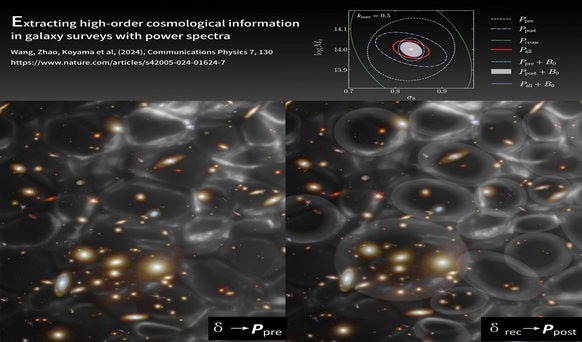Reviewed by Lexie CornerApr 23 2024
Scientists from the National Astronomical Observatories of the Chinese Academy of Sciences (NAOC) and international collaborators have developed a new method for analyzing data from galaxy surveys. This method allows them to extract more information about the universe's structure and dark matter/energy. Their findings were published in Communications Physics.
 An illustration of the main idea and results from Wang et al. Communication Physics. Image Credit: National Astronomical Observatories of the Chinese Academy of Sciences
An illustration of the main idea and results from Wang et al. Communication Physics. Image Credit: National Astronomical Observatories of the Chinese Academy of Sciences
In this era of precision cosmology, massive galaxy redshift surveys are powerful tools for exploring the Universe. Astronomers can create density fields of galaxies at different epochs of the Universe by observing a large number of spectra from distant galaxies. These density fields contain important information about galaxy clustering, expressed in terms of N-point (N > 2) and two-point correlation functions.
The information content in the N-point functions is highly complementary to that in the two-point functions. The nature of dark energy, dark matter, and gravity are studied with great importance, thanks to the N-point functions. However, it is challenging to use the N-point functions in practice due to many complications, including the measurement and modeling of these quantities.
Yuting Wang, the first author of this work and a researcher at NAOC, and her colleagues have worked on this difficult task for a few years, and they have created a new technique for extracting information from the two-point functions into the N-point functions.
This new method, which is based on a technology called density reconstruction, makes it possible to extract the primary information in the three-point and four-point functions by a joint analysis of the two-point functions measured from the pre- and post-reconstructed density fields, respectively.
Gongbo Zhao, Study First Corresponding Author and Group Leader, National Astronomical Observatories of the Chinese Academy of Sciences
Zhao said, “This opens a new window for using the high-order information in galaxy surveys in an efficient way, and that is important for cosmological implications for forthcoming galaxy surveys, including Dark Energy Spectroscopic Instrument (DESI), Prime Focus Spectrograph (PFS), and China Space Station Telescope (CSST).”
This work was supported by the Natural Science Foundation of China (NSFC), China’s Ministry of Science and Technology (MOST), and the Chinese Academy of Sciences (CAS).
Journal Reference:
Wang, Y., et al. (2024) Extracting high-order cosmological information in galaxy surveys with power spectra. Communications Physics. doi.org/10.1038/s42005-024-01624-7